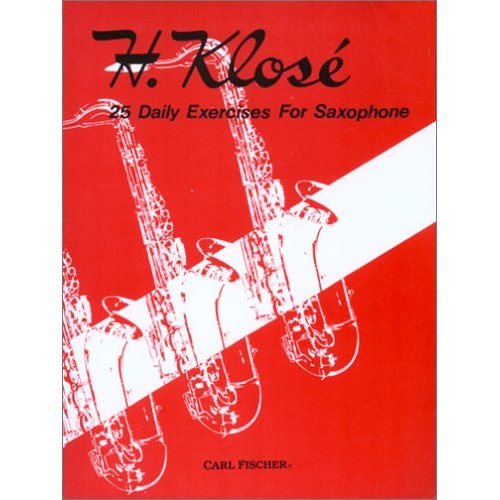The Klose Exercises and 6 Ways to Seriously Boost Your Playing
 This guest post is from saxophone and multi-reed player, composer, recording artist, and educator Sam Sadigursky of SamSadigursky.com
This guest post is from saxophone and multi-reed player, composer, recording artist, and educator Sam Sadigursky of SamSadigursky.com
I recently have been working extensively with a student on the Klose book of 25 Daily Exercises for Saxophone, which are an absolute essential for any saxophonist who is looking to improve their technique. In many ways, it might be the only such book you’ll ever need. The studies cover so much of the saxophone that thorough work on them should enable you to build the speed and dexterity that you’re looking for, not to mention sound productions and evenness of tone. My copy of the book has been with me almost 20 years and has circled the globe more than a few times too, to the point where it’s falling apart and starting to look like some sort of ancient religious text.
I’ve recently been spending time with them again, both with my student and on my own, and want to share some different ways that you might go about practicing them. Many of these ideas came from my teacher, Vince Trombetta, to whom I give full credit.
1. Use different articulations.
The written ones are good and quite detailed, but try playing the etudes totally legato (which may help increase speed) or totally staccato. Jazz saxophonists can play them with a basic swing articulation and feel. Or create your own articulation pattern!
2. Play them at different speeds.
Slow, medium, fast… whatever you want. Evenness at any speed is always a challenge. You can even try putting the metronome at unusual parts of the measure.
3. Practice the etudes, or just small excerpts from them, in all 12 keys.
This will help your musical brain, ears, and fingers tremendously. Most of the etudes are in C Major, which makes this easier to do, and so much of the melodic material is made up of common musical ideas and patterns that you’ll end up building your vocabulary. Also, being able to transpose to your instrument’s key from concert key is an essential skill that will open entire musical worlds to you. If you want to get really creative, you can change keys within an etude, every line or even every measure if you really want to get creative!
4. Practice the etudes using all overtone fingerings.
If you’re unfamiliar with these, go to the article, Intro to Saxophone Overtones.
5. Practice the exercises without using the octave key at all.
This is great training for more advanced players.
6. Use these etudes for your flute and clarinet practice if you’re a doubler.
They lay great on those instruments. You can even switch from one to the other in the middle of the pieces in order to facilitate the ability to go from one to another smoothly. No matter how you practice them, make sure you’re really finding the problem areas and zeroing in on them. Nothing should ever feel or sound labored or uneven.
Also, nothing you play is just for your fingers. Your sound is more important than anything, and if you practice carefully these etudes are a great way of developing lasting ease and evenness of tone.
Study with Sam
Sam Sadigursky is currently offering online lessons through Skype and private lessons in NYC. He has given improvisation clinics across the U.S., is a regular guest professor at Hunter College, and currently performs internationally with Darcy James Argue’s Secret Society, Folklore Urbano, and others. To find out more, visit SamSadigursky.com.






August 6, 2011 @ 3:37 pm
Liked this article. My teacher had me do similar things with the book like playing excerpts from a couple of studies in all keys, playing one study in F instead of C, then eventually taking through other keys. I also practise these on clarinet and flute as warmups.
I sometimes wish I could just use one technique book for all my doubles since I have limited time. Maybe Klose could be good for this, although I don’t know of anyone who does this.
September 29, 2018 @ 10:19 am
Helpful article – I haven’t been able to play for a while and these are great way of getting back into practice.
I’m using them for accuracy rather than speed.